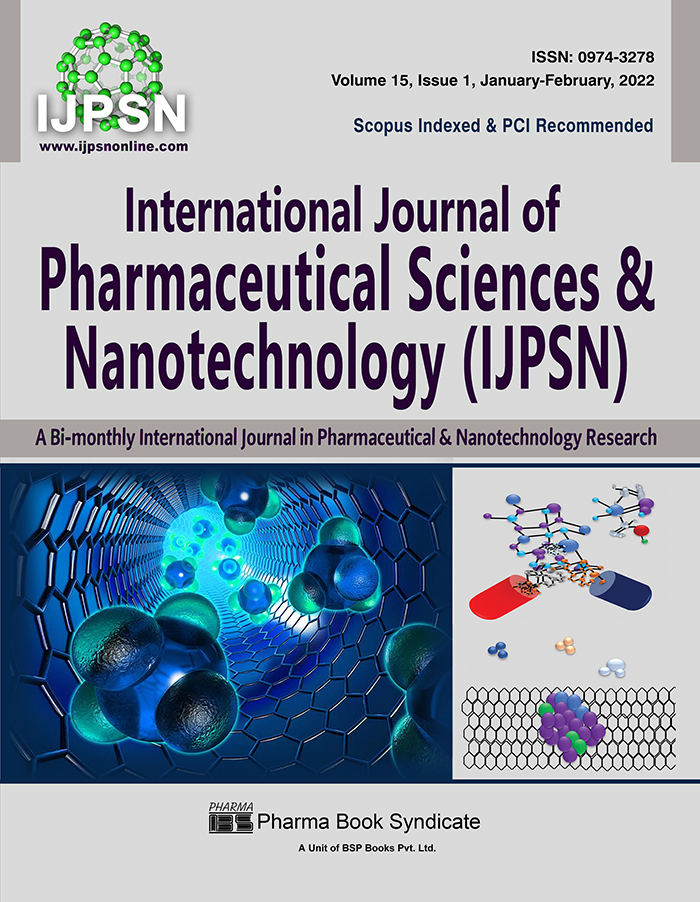Green Synthesis and Evaluation of Zinc Oxide Nanoparticles from Manilkara Zapota Leaf Extract
DOI:
https://doi.org/10.37285/ijpsn.2022.15.1.10Abstract
Background: Zinc oxide Nanoparticles can be prepared by various chemical, physical, and biological methodologies. But biological approach is easier than the other methods and also eco-friendly.
Purpose of study: Plant-mediated amalgamation of Zinc oxide nanoparticles is promising contrast to traditional method of physical and chemical synthesis.
Method: In the current research work, Zinc oxide nanoparticles are synthesized by using Leaf extracts of Manilkara Zapota plant. Green synthesis was done utilizing the aqueous solution of Manilkara Zapota leaf extract as reducing agent and Zinc acetate salts along with Sodium hydroxide. Morphological, Structural and Antimicrobial properties of synthesized Zinc oxide nanoparticles were characterized using Scanning electron microscope, Fourier transform infrared analysis, Differential scanning calorimetry and Disc diffusion method. '
Results: Biologically synthesized nanoparticles of Manilkara Zapota leaf extract revealed significant Anti-bacterial and Anti-fungal activities.
Cocnclusion: The organically incorporated nanoparticles by Manilkara Zapota can be utilized as antimicrobial agent against various pathogenic organisms.
Downloads
Metrics
Keywords:
Anti-microbial, Biological approach, Green synthesis, Leaf extract, Manilkara Zapota, Plant mediated, Zinc oxide NanoparticlesDownloads
Published
How to Cite
Issue
Section
References
Asha Chaudhary, Naresh Kumar, Ravinder Kumar, Raj Kumar Salar (2018). Antimicrobial activity of zinc oxide nanoparticles synthesized from aloe Vera peel extract. SN Applied sciences, 1: 1-9.
Ashwath Narayana B S, Kushal Pandey , Nasehuddin Azmi , Tejashwini M , Umang Shrestha , S V Lokesh (2018). Synthesis and characterization of zinc oxide (ZnO) nanoparticles using mango (mangifera indica) leaves. IJRAR, 5(3).
Amit Singh, Neelam, Mahima Kaushik (2018). Physicochemical investigations of zinc oxide nanoparticles synthesized from Azdirachta indica (Neem) leaf extract and their interaction with calf-thymus DNA. Science direct.
Fenglian Wua, Yanxin Chenb, Guoliang Lic, Donglai Zhua, Lianying Wanga and Jiaxin Wanga (2019). Zinc oxide nanoparticles synthesized from Allium cepa prevents UVB radiation mediated inflammation in human epidermal keratinocytes (HaCaT cells). Artificial cells, nanomedicine, and
biotechnology, 47(1): 3548–3558.
G. Parthasarathy, M. Saroja, M.Venkatachalam, V. K. Evanjelene (2017). Characterization and antibacterial activity of green synthesized ZnO nanoparticles from Ocimum basilicum leaf extract. Advances in bioresearch, 8(3): 29-35.
Haritha Meruvu, Meeena Vangalapati, Seema Chaitanya Chippada and Srinivasa Rao Bammidi (2011). Synthesis and characterization of Zinc oxide nanoparticles and its antimicrobial activity against bacillus subtilis and Escherichia coli. RASAYAN J.Chem, 4(1): 217-222.
Huma Aslam (2020). Synthesis and evaluation of ZnO nanoparticles of Trigonella foenum for their biological activities. Capital University of science and technology.
Karthiga Rajendaran, Sudha Annamalai (2015). Green synthesis of ZnO nanoparticles using Sollanam Santhocarbon to study its solarphotocatalytic activity. International journal of science and research, 6(6).
K. Lingaraju, H. Raja Naika, K. Manjunath, R. B. Basavaraj, H. Nagabhushana, G. Nagaraju, D. Suresh (2016). Biogenic synthesis of zinc oxide nanoparticles using ruta graveolens (L.) and their antibacterial and antioxidant activities. Appl Nanosci, (6): 703-710.
Namita Soni, Ramesh C. Dhiman (2020). Larvicidal and antibacterial activity of aqueous leaf extract of Peepal (Ficus religiosa) synthesized nanoparticles.Parasite epideomology and control, 11.
N.Matinise, X.G.Fuku, K. Kaviyarasu, N. Mayedwa, M. Maaza (2017). ZnO nanoparticles via Moringa oleifera green synthesis: Physical properties & mechanism of formation. Applied surface science, 339-347.
Shreya Modi, M. H. Fulekar (2020). Green Synthesis of Zinc Oxide Nanoparticles Using Garlic Skin Extract and Its Characterization. J Nanostruct, 10(1): 20-27.






